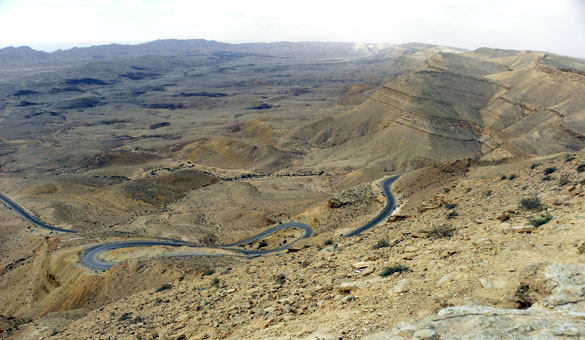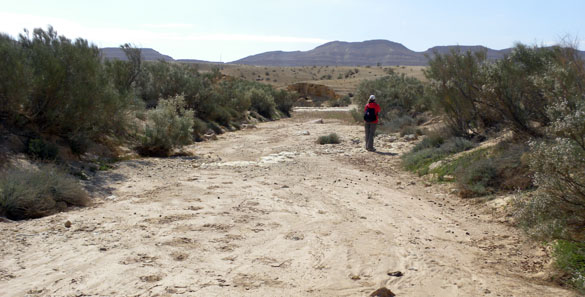 MITZPE RAMON, ISRAEL–Compare the image above to the one taken in the same place two days ago. Much better! Our only dust today was a local product from the unending winds. The Saharan dust is gone. We paid for this clarity, however, with a dramatic drop in temperature. It was 8°C (46°F) when we started work this morning. This is typical for spring fieldwork in the northern Negev. The weather is less predictable, and the temperatures can swing wildly from day to day. The summers are very predictable: sunny, hot, dry, and not a breeze. I don’t take my hat’s chinstrap in the summers, but in the spring it is tied firmly all day.
MITZPE RAMON, ISRAEL–Compare the image above to the one taken in the same place two days ago. Much better! Our only dust today was a local product from the unending winds. The Saharan dust is gone. We paid for this clarity, however, with a dramatic drop in temperature. It was 8°C (46°F) when we started work this morning. This is typical for spring fieldwork in the northern Negev. The weather is less predictable, and the temperatures can swing wildly from day to day. The summers are very predictable: sunny, hot, dry, and not a breeze. I don’t take my hat’s chinstrap in the summers, but in the spring it is tied firmly all day.
Our goal today was to travel as far south as we could along the strike of the Matmor Formation, sampling “subunit 51” when we could. Melissa and I walked into the makhtesh about five kilometers. This was not a long distance, but in the summer we just couldn’t carry enough water to pull it off without a four-wheel drive vehicle.
 We walked south from the Negev Minerals mine, where we park, along an old pipeline road until we reached Wadi Hatira (shown above). This is the wadi that drains the makhtesh through its single opening in the northeast. It is the greenest zone in the structure because it has the most soil moisture. There were some beautiful flowers along its banks, photos of which I’ll post later. From the wadi we climb up to the old British road and continue south into the Matmor Hills.
We walked south from the Negev Minerals mine, where we park, along an old pipeline road until we reached Wadi Hatira (shown above). This is the wadi that drains the makhtesh through its single opening in the northeast. It is the greenest zone in the structure because it has the most soil moisture. There were some beautiful flowers along its banks, photos of which I’ll post later. From the wadi we climb up to the old British road and continue south into the Matmor Hills.
 Melissa is standing above at the base of Subunit 51 of the Matmor Formation (Middle Jurassic). This is typical of its exposure in the central part of the makhtesh where there is higher relief in the Matmor Hills. The unit is difficult to follow because of an abundance of small faults cutting perpendicular to strike. Its marly nature means it is often covered with debris from the units above. The northern outcrops have lower relief, which in our case means we have more gentle slopes to search for fossils.
Melissa is standing above at the base of Subunit 51 of the Matmor Formation (Middle Jurassic). This is typical of its exposure in the central part of the makhtesh where there is higher relief in the Matmor Hills. The unit is difficult to follow because of an abundance of small faults cutting perpendicular to strike. Its marly nature means it is often covered with debris from the units above. The northern outcrops have lower relief, which in our case means we have more gentle slopes to search for fossils.
 Around noon we ran into a camel herd wandering around our outcrops. (The most active of the beasts is shown above.) They had calves with them and were immediately disturbed by our appearance. They started to make angry camel noises. We did not want a run in with riled-up camels, nor did we want to give their Bedouin herdsmen any reason to think we were harassing them. Since the camels weren’t going anywhere, we reluctantly turned around and headed back.
Around noon we ran into a camel herd wandering around our outcrops. (The most active of the beasts is shown above.) They had calves with them and were immediately disturbed by our appearance. They started to make angry camel noises. We did not want a run in with riled-up camels, nor did we want to give their Bedouin herdsmen any reason to think we were harassing them. Since the camels weren’t going anywhere, we reluctantly turned around and headed back.
 To aid our decision to retreat, the skies looked very threatening (see above). Rain? Who would have thought? We could smell rain and see what looked like rain to the northeast. We did not want to be in a big rock bowl if it really did pour, so we hastened back to the car. It didn’t actually rain on us, but it may have in the makhtesh after we left.
To aid our decision to retreat, the skies looked very threatening (see above). Rain? Who would have thought? We could smell rain and see what looked like rain to the northeast. We did not want to be in a big rock bowl if it really did pour, so we hastened back to the car. It didn’t actually rain on us, but it may have in the makhtesh after we left.
We got a minimum amount of work done today, though, so it was not a loss. Now we’re back in our warm rooms listening to the wind continue to howl outside.



































